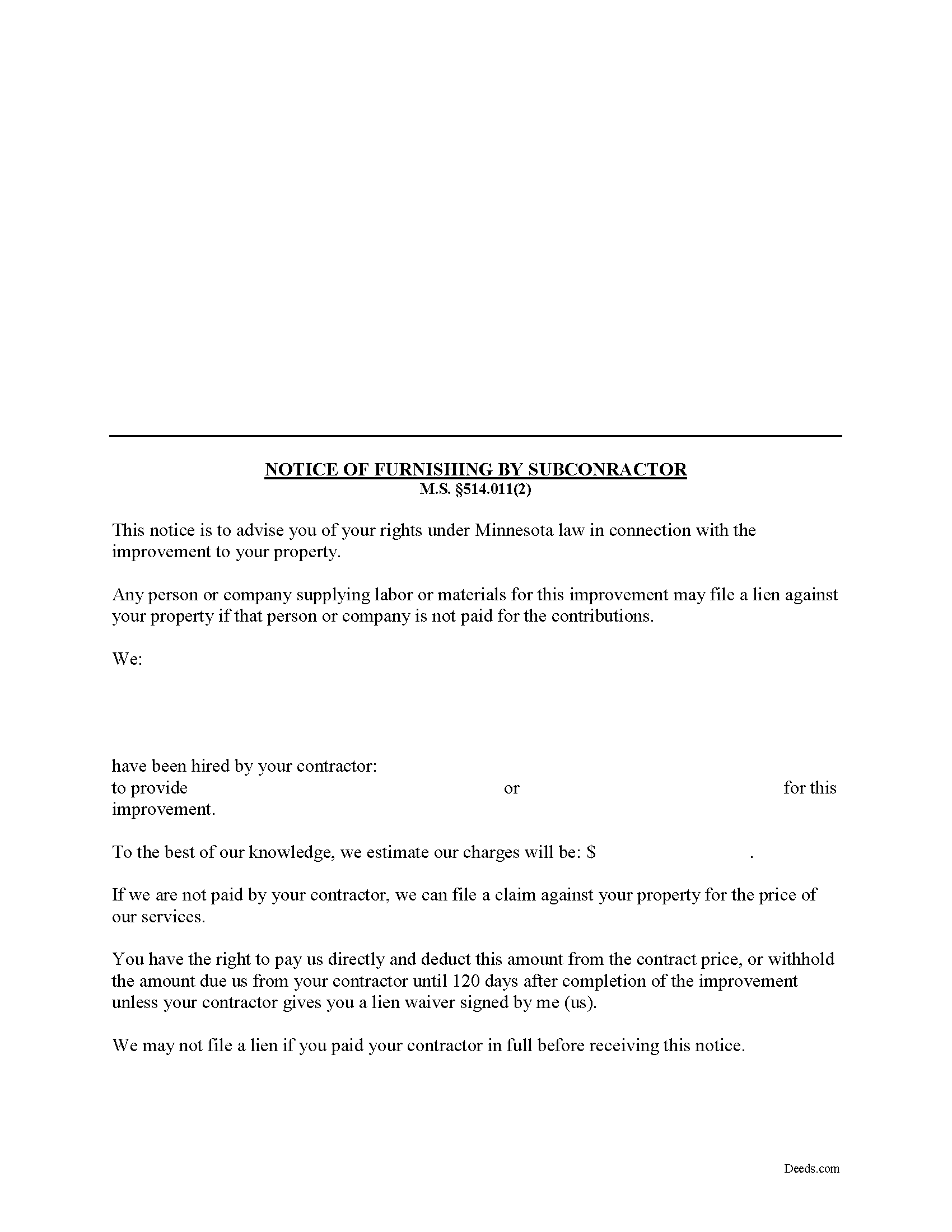Download Minnesota Subcontractor Notice of Furnishing Legal Forms

Minnesota Subcontractor Notice of Furnishing Overview

What notice must a subcontractor give to protect lien rights in Minnesota?
Notice is a key element to the substance of mechanic's lien law. To successfully maintain an action for a mechanic's lien, a lien claimant must strictly comply with the notice requirements. In Minnesota, subcontractors, or contractors not in direct written contract with the owner, must provide the proper pre-lien notice. Subcontractors in this state may use a notice form known as the "Subcontractor's Notice of Furnishing."
Under the State's law, every person who contributes to the improvement of real property, except a party under direct contract with the owner must, as a necessary pre-condition to claiming a lien, give the owner or the owner's authorized agent a written notice of furnishing, no later than 45 days after the lien claimant has first furnished labor, skill or materials for the improvement. M.S. 514.011(2)(a). The notice must be delivered either by personal delivery or certified mail. Id. For the purposes of the statute, "owner" means the owner of any legal or equitable interest in the real property whose interest in the property: (1) is known to one who contributes to the improvement of the real property, or (2) has been recorded or filed for record if the property is registered land, and who enters a contract for the improvement of the real property. M.S. 514.011(5).
The notice includes the following information: (1) name and address of the subcontractor; (2) name of the contractor who contracted with the subcontractor; (3) the type or service furnished or (4) the type of materials furnished; and (5) estimated value of the services or materials furnished. 514.011(2)(a). The subcontractor must then sign and notarize the form.
There are three exceptions for when the notice does not have to be given. The first is when there is a same ownership interest between the parties. The notice is not required when the contractor is managed or controlled by the same persons (or substantially the same) who manage or control the owner of the improved real estate. M.S. 514.011(4)(a). The next exception occurs when there are multiple residential dwellings, for example during construction of a subdivision. The notice is not required when an improvement to real property consisting of or providing more than four family units for improvements that are wholly residential in character. M.S. 514.011(4)(b). Lastly, notice is not required for an improvement to real property, that is not in agricultural use and which is wholly or partially nonresidential in use if the work or improvement: (a) is to provide or add more than 5,000 total usable square feet of floor space; or (b) is an improvement to real property where the existing property contains more than 5,000 total usable square feet of floor space; or (c) is an improvement to real property which contains more than 5,000 square feet and does not involve the construction of a new building or an addition to or the improvement of an existing building. M.S. 514.011(4)(c).
So, to wrap things up, the preliminary notice is an important feature of the lien law and works to protect the owner of the property from "hidden" liens. Protect your lien rights by ensuring that you serve the required notice on the proper parties by keeping track of important deadlines and knowing the parties that you're dealing with.
This article is provided for informational purposes only and is not intended to be relied upon as a substitute for the advice of an attorney. Please consult with a licensed Minnesota attorney with any questions about serving preliminary notice as a subcontractor, or any other issues relating to liens.